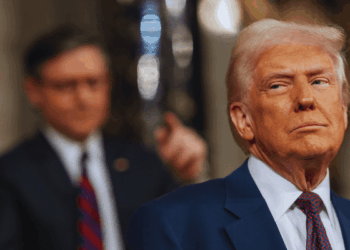This article originally appeared in National Security Journal.
By Stephen Nagy, August 22, 2025
China’s behavior has not changed since the founding of the People’s Republic of China (PRC). It aims to create wedges between America and its allies in the hope of undermining U.S. economic, political, diplomatic and security interests in the Indo-Pacific region.
Prominent Scholar Yan Xue Tong of Tsinghua University explained China’s long-term interests this way:
“China will work hard to shape an ideological environment conducive to its rise and counter Western values. For example, the United States defines democracy and freedom from the perspective of electoral politics and personal expression, while China defines democracy and freedom from the perspective of social security and economic development. Washington should accept these differences of opinion instead of trying to impose its own views on others.”
In the context of the Trump 2.0 administration’s economic tactics against Ottawa, Beijing is exploiting Canada-U.S. tensions to advance its interests along these subtle lines.
The troubling reality behind those Canadians who advocate for rapproachment with China is that while defense and security experts understand China’s strategic challenge, business leaders chase profits. These opportunistic voices use anti-Trump and anti-American sentiment to advocate for closer ties with Beijing, further distancing Canada from its most important partner.
Beijing’s tactics to dismantle the U.S. alliance network are neither new nor subtle. Since the arrest of Huawei’s Meng Wanzhou in 2018, China has systematically worked to drive wedges between Ottawa and Washington. The subsequent detention of Michael Kovrig and Michael Spavor demonstrated Beijing’s willingness to use hostage diplomacy against Canada. Now, with Trump’s tariff threats dominating headlines, China sees an opportunity to position itself as an alternative partner.
The pattern is clear. Chinese state media regularly amplifies Canadian grievances against the United States while portraying China as a reliable economic partner. When Trump threatens 25% tariffs, Beijing’s diplomats quickly remind Canadian businesses of China’s vast market. When USMCA disputes arise, Chinese officials suggest their trade relationships come with “fewer political strings attached.”
This messaging finds receptive audiences among those who conflate opposition to Trump with the need to distance Canada from the U.S. entirely. Anti-Americanism manifests in business forums like the Canada-China Business Council (CCBC) where executives argue that diversifying toward China is simply good risk management. It appears in academic conferences where scholars suggest that multipolarity requires Canada to hedge between Washington and Beijing. It emerges in media commentary that portrays any security cooperation with the U.S. as compromising Canadian sovereignty.
But this narrative fundamentally misunderstands both China’s intentions and Canada’s actual challenges. China’s behavior across the Indo-Pacific, from economic coercion against Australia to political interference in New Zealand, makes the pattern clear: Beijing seeks not partnership but leverage to negatively shape the behavior of America’s allies such that it weakens cooperation.
The business community’s “great greed” manifests in willful blindness to these patterns. Canadian pension funds pour billions into Chinese assets despite mounting evidence of forced labor in Xinjiang. Mining companies chase rare earth partnerships while ignoring how Beijing weaponizes critical mineral supplies. Tech firms pursue Chinese market access while their intellectual property disappears into joint ventures that become competitors.
Australia’s experience should serve as a cautionary tale. When Canberra called for an independent investigation into COVID-19’s origins, Beijing responded with trade sanctions that blocked wine, barley, and beef imports. The message was clear for Canberra, economic dependence on China comes with political subservience as the price.
Yet the most dangerous delusion is believing Canada’s current economic problems would be solved by pivoting toward China. The truth, uncomfortable as it may be, is that Canada’s economic challenges are largely self-inflicted, predating Trump’s return to office.
Canada’s productivity growth has lagged the U.S. for over a decade. The Trudeau government’s emphasis on redistribution over growth, exemplified by ever-expanding government spending without corresponding economic reforms, created structural weaknesses. Business investment fled not because of Trump but because of regulatory uncertainty, rising taxes, and ideological hostility toward resource industries.
The immigration system, once Canada’s strength, broke under the weight of unrealistic targets and poor planning. The previous government’s decision to dramatically increase immigration without corresponding investments in housing, healthcare, or integration services created backlash that populists now exploit. These weren’t Trump’s policies, they were political choices by the leadership in Ottawa.
Crime rates and drug overdoses surged until 2024 due to failed harm reduction strategies and weak enforcement, not American pressure. The toxic drug crisis killing thousands of Canadians annually stems from domestic policy failures, particularly in British Columbia where decriminalization experiments went disastrously wrong.
Separatist sentiments simmer from Quebec to Alberta not because of Washington but because of Ottawa’s inability to balance regional interests. The previous government’s divisive approaches including from Bill C-69’s impact on energy projects to cultural policies that inflamed Quebec nationalism deepened these fractures.
Even Canada’s international credibility eroded before Trump’s tariff threats. The unseemly pursuit of a UN Security Council seat, the confusion over Indo-Pacific strategy, and the inability to meet NATO spending commitments all damaged Canada’s standing. Allied capitals increasingly viewed Canada as unreliable, more interested in moral posturing than burden-sharing.
The path forward requires honest recognition of these realities. Canada needs a competitiveness agenda focused on productivity growth, not redistribution. This means tax reform to attract investment, regulatory streamlining to enable development, and skills training aligned with economic needs rather than ideological preferences.
On China, Canada must adopt what I call “principled realism.” This means:
First, maintaining security alignment with the U.S. and other democratic allies. The Five Eyes intelligence partnership, NORAD, and NATO remain foundational to Canadian security. No amount of trade with China can replace these arrangements.
Second, implementing strict investment screening for Chinese acquisitions in critical sectors. Australia’s Foreign Investment Review Board model, strengthened after bitter experience, provides a template. New Zealand also has produced similar review mechanisms to distinguish between opportunity and vulnerability.
Third, diversifying trade relationships toward democratic partners. The Comprehensive and Progressive Agreement for Trans-Pacific Partnership (CPTPP) offers access to growing markets without authoritarian strings attached. Creatively finding ways for political entities such as Taiwan to join will be important in this diversification process demonstrating that criteria, not politics is the denominator for CPTPP membership.
Fourth, protecting Canadian institutions from Chinese interference. This requires implementing foreign agent registration, securing research partnerships, and defending diaspora communities from transnational repression.
Finally, engaging China where necessary but with clear eyes. Climate cooperation, for instance, remains essential, but shouldn’t blind Canada to Beijing’s human rights abuses or territorial expansionism in the South China Sea, East China Sea and in the Himalayan plateau.
The idea of a world where the U.S. isn’t Canada’s closest partner is alarming. Look at states that chose China over their democratic allies: Sri Lanka faces debt trap diplomacy, Pakistan endures economic colonialism, and Myanmar’s military enjoys Beijing’s protection while massacring civilians.
Canada’s geography, history, and values make the choice clear. The U.S., despite periodic friction, even under the Trump 2.0 administration shares Canada’s commitment to democracy, human rights, and open markets. China offers only transactional relationships that demand political compliance as the price of market access.
Trump’s tariff threats, however misguided, will pass. But the strategic challenge posed by authoritarian China will define the coming decades. Those advocating closer ties with Beijing amid current tensions are not visionaries but opportunists selling a false promise. China is a false prophet that will use its economic relationship to undermine Canada’s relationship with the U.S. and our democracy as it has done in the past.
Canada’s real challenges require domestic reforms and renewed commitment to democratic alliances, not naive faith in authoritarian alternatives.
Dr. Stephen Nagy is Professor of Politics and International Studies at the International Christian University. He is a senior fellow at the Macdonald-Laurier Institute and the Center for North American Prosperity and Security; a Visiting Fellow for the Hungarian Institute for International Affairs (HIIA) June 13th, -August 30th, 2025 and a Distinguished Fellow at the Corvinus Institute for Advanced Studies (CIAS), Corvinus University, Budapest July 2025. He is currently working on middle-power approaches to great-power competition in the Indo-Pacific. The tentative title for his forthcoming monograph is “Navigating U.S. China Strategic Competition: Japan as an International Adaptor Middle Power.”








